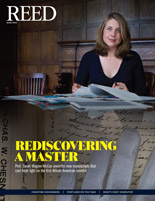
IRIS login | Reed College home Volume 94, No. 2: June 2015
Reediana
Goodhouse (Farrar, Straus and Giroux, 2014)
Peyton Marshall ’96

Toward the end of the 21st century in a suburb of Ione, California, a 17-year old boy named James chops wood and bites his lip as a gaggle of high-society women pepper him with intrusive questions. It is his first community day, when James and his fellow Goodhouse students are bussed to local communities to spend time with ordinary citizens. James is desperate to prove to the women that he is a hardworking young man, not a subhuman monster.
The stakes and dystopian, classist tension are thus set in Peyton Marshall’s critically acclaimed first novel, Goodhouse, loosely based on California’s notorious Preston School of Industry, a now-shuttered reform school for orphans and juvenile offenders. In Peyton’s novel, children identified as having the genetic marker for criminality are taken from their families and sent to Goodhouses—part prison and part reform school—in order to be taught right-thinking and how to repress their darkest desires and deviant impulses. The boys are even given the surname Goodhouse to blot out their past and individuality.
We follow James, the book’s protagonist, as he navigates his final year in his Goodhouse. A year prior to the book’s events, he witnessed a terrible fire that destroyed his home in LaPine, Oregon, and killed many of his friends. Reliving the memory, James wonders if he has escaped danger as he meets the school’s nefarious director of medical studies and Bethany, a smart and mischievous girl with a mysterious interest in him. He learns of a prison bordering the school and a radical religious fringe group that wants to destroy the Goodhouses and the boys who live in them. As the novelnreaches its thrilling conclusion, neither James nor the reader can be certain whether his experiences are random, confusing happenstance or signs of a world order on the brink of collapse.

LATEST COMMENTS
steve-jobs-1976 I knew Steve Jobs when he was on the second floor of Quincy. (Fall...
Utnapishtim - 2 weeks ago
Prof. Mason Drukman [political science 1964–70] This is gold, pure gold. God bless, Prof. Drukman.
puredog - 1 month ago
virginia-davis-1965 Such a good friend & compatriot in the day of Satyricon...
czarchasm - 4 months ago
John Peara Baba 1990 John died of a broken heart from losing his mom and then his...
kodachrome - 7 months ago
Carol Sawyer 1962 Who wrote this obit? I'm writing something about Carol Sawyer...
MsLaurie Pepper - 8 months ago
William W. Wissman MAT 1969 ...and THREE sisters. Sabra, the oldest, Mary, the middle, and...
riclf - 10 months ago